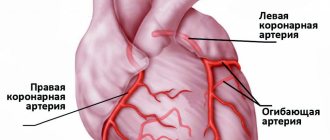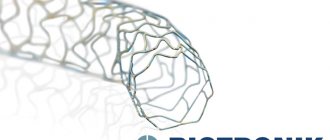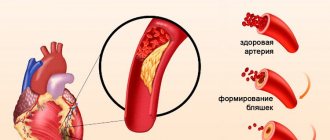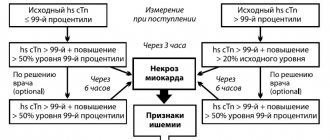Myocardial infarction: symptoms, signs of the need for first aid
Myocardial infarction in medicine is defined as the development of necrotic changes in the heart.
This is one of the most acute clinical forms of IHD (coronary heart disease). The disorder occurs due to acute insufficiency of blood flow due to a failure in the supply of oxygen to the heart muscle. A heart attack may be indicated by sudden sweating, nausea, pain in the sternum, forearm and other parts of the body. Heart attacks in men occur 5 times more often than in women, which is especially noticeable in young and middle-aged people. Heart attacks in women develop on average 10-12 years later than in men. Among the reasons is the later development of atherosclerotic changes, which is facilitated by less widespread bad habits and the protective effect of estrogens in women.
About heart attack in detail
Modern possibilities of medicine in the fight against angina pectoris and myocardial infarction.The reason for the death of every second person is heart and vascular disease. This is due to the colossal prevalence of vascular damage by atherosclerosis, which is largely a consequence of many years of habitual, but unhealthy lifestyle of a person.
In the wall of the vessels that supply the heart with blood (coronary arteries), over time, fatty deposits appear from the inside, which are called atherosclerotic plaques . Plaques gradually grow and cause a narrowing of the artery ( stenosis ), which naturally reduces blood flow to the heart. Since this is a gradual process, the heart muscle adapts to it for quite some time, for the time being the person feels normal, unaware of what is happening in his blood vessels. As a rule, only when the artery is narrowed by a growing plaque by three quarters of the lumen or more, ischemic heart disease (CHD) .
Initially, IHD manifests itself during physical and emotional stress. At the moment of exertion (which is most typical for ischemic heart disease), paroxysmal pain occurs in the center of the chest (behind the sternum) - angina pectoris . They can be burning, squeezing, and sometimes cause a feeling of lack of air. This is a signal that the heart muscle (myocardium) in the area of vessel narrowing is experiencing a lack of blood supply - ischemia . Stopping physical activity, taking nitroglycerin and other drugs that affect blood vessels, relieves (relieves) pain and improves well-being. But it does not eliminate the cause of ischemia—vasoconstriction.
Gradually, as the atherosclerotic plaque grows, the narrowing of the lumen of the vessel can reach the point of complete blockage, or chronic occlusion . Attacks of angina pectoris become more frequent, occurring with the most ordinary slight physical effort, significantly limiting a person’s ability to work and vital activity, and practically disabling him.
Another variant of the development of IHD is possible - acute . A plaque narrowing the lumen (Fig. 1a) creates conditions for platelets from the blood flowing through the vessel to adhere to it (aggregation) and the formation of a blood clot on the plaque - thrombus , which sharply reduces the lumen of the vessel in this place, suddenly leading to blockage of the coronary artery - acute occlusion . As a result, the blood flow to the corresponding part of the heart supplied by this vessel suddenly and abruptly stops - myocardial infarction . Approximately 15 minutes after the cessation of blood flow through the thrombosed vessel, cardiac muscle cells in the area of severe ischemic damage begin to die, and already at this stage the disease is fraught with acute, often fatal complications. After 6-8 hours, this zone of the myocardium completely dies. If ischemic chest pain lasts more than 15-30 minutes, and nitroglycerin does not bring relief, an urgent call to the doctor, an ECG and a troponin test are necessary to exclude myocardial infarction . An attempt to eliminate blockage of a coronary vessel is possible by introducing special substances that dissolve a blood clot - thrombolytics , but coronary anoplasty and stenting of the vessel from within its lumen are more effective. You can avoid the formation of a heart attack only by starting this treatment no later than 3-6 hours after the onset of pain . After necrosis of the infarction area, removing the blockage of the vessel that caused it and restoring blood flow through this vessel will be useless.
To accurately detect the cause of angina or myocardial infarction in the coronary vessels, coronary angiography or coronary angiography . X-ray video images performed in a special way during this study (Fig. 3) make it possible to determine the exact location of atherosclerotic plaques and the degree of narrowing of the coronary arteries.
Detected acute thrombotic occlusions during a heart attack, as well as vascular stenoses and in some cases chronic occlusions in severe angina (Fig. 2) can be expanded from inside the vessel - this procedure is called coronary angioplasty. Under the control of an x-ray image, the doctor passes a special balloon to the site of narrowing and expands it, pressing atherosclerotic plaques into the walls of the artery (Fig. 4-5). The lumen of the vessel and normal blood flow through it are restored. To reduce the likelihood of re-occurrence of narrowing at the site of the “crushed” plaque and to reliably keep the lumen of the vessel in an “open” state, a stent . The stent is a mesh metal frame, “clad” on a balloon in a compact state. After insertion into the artery, the stent is expanded by a balloon that inflates at the site of narrowing, expands from the inside to the normal diameter of the vessel lumen and, maintaining this unchanged state after deflation and removal of the balloon, keeps the vessel lumen completely open (Fig. 6). This operation is called stenting . Millions of such operations are performed every year around the world.
Thus, early seeking qualified help allows for effective and long-term restoration of normal heart function.
If you or your loved ones have developed a myocardial infarction, or a picture of acute coronary syndrome (pre-infarction condition), and the emergency doctor considers urgent hospitalization necessary, if possible, insist on choosing a medical institution where coronary angioplasty and stenting of a vessel can be urgently performed, blockage which led to the development of a heart attack. This operation, performed on time (as early as possible), in the first hours after the development of myocardial infarction, can significantly limit its area in the heart muscle, and often reverse the course of events and prevent it.
The organization of treatment in clinics in St. Petersburg, Moscow and other Russian cities is provided by leading specialists in the field of angioplasty and vascular stenting.
Causes of myocardial infarction
Myocardial infarction develops for various reasons, some of which are contributed by the person himself, others by his environment. Let us highlight 3 main groups of provoking factors:
- Factors that directly depend on the person - eating large amounts of fatty foods, smoking, excessive alcohol consumption.
- Factors that indirectly depend on a person are obesity, menopause and postmenopause.
- Factors that do not depend on a person - old age, genetic predisposition.
Myocardial infarction develops with atherosclerosis and inflammation in the walls of the arteries resulting from trauma, radiation exposure, vascular embolism, congenital anomalies and disruptions of the hematopoietic apparatus.
Heart attack: symptoms and first signs
- Patients do not always associate symptoms of a heart attack with the manifestation of this pathology. The patient’s feelings depend on what period of its development the disease is at. Common signs of a heart attack:
- severe dizziness, feeling of lack of air, shortness of breath;
- feeling of chronic fatigue, cold sweat on the body;
- uneven heartbeat, severe arrhythmia;
- pain impulses in the arms, forearms, shoulders, side, sternum;
- nausea, unpleasant heaviness in the stomach, loss of consciousness.
The first signs of a heart attack are not always obvious, but they attract attention. There are several periods of development of pathology:
- Pre-infarction stage - the first signs here are increased fatigue, weakness, fatigue, a feeling of squeezing and rapid heartbeat. There is no significant pain yet. In a patient with myocardial infarction, the lips and nail plates turn blue, the pulse becomes erratic and uneven. At this time, the severity of the disease increases, the duration of the period ranges from a couple of hours to a month.
- The most acute stage of heart attacks is pain. The patient begins to feel as if his chest is being squeezed in a vice. Behind the sternum there is a burning sensation, fiery heat, pulsating pain. With the development of an extensive heart attack, the pain is severe and prolonged. Strong and abrupt impulses are observed in young patients. Muffled pain, indicating myocardial infarction, is more often observed in patients with diabetes mellitus. The duration of the period is from half an hour to 2-4 hours. Complications that pose a direct threat to life are possible.
- Acute stage of a heart attack - among the first symptoms, the final formation of a focus of dead tissue and the occurrence of life-threatening conditions are noted. The duration of the period is 2-14 days.
- Subacute period - dead areas are replaced by connective tissue. The duration of the stage is 6-8 weeks.
- The post-infarction period lasts from two months to six months. During this time, the body adapts to new conditions.
If there are signs of a heart attack, you should not self-medicate; you should urgently consult a doctor, undergo an examination and get specialist recommendations.
Signs of atypical myocardial infarction in women and men
Atypical signs of the disease are observed in elderly patients who have experienced one or more myocardial infarctions. Based on the nature of the symptoms, several atypical forms are distinguished:
- the abdominal form is characterized by indigestion, nausea, vomiting, hiccups;
- in the asthmatic form, the patient feels suffocated and may develop a cough;
- the cerebral form is represented by dizziness, presyncope;
- atypical pain syndrome (toothache, pain in the neck, left ear, spine, left leg, left fingers).
Often, acute myocardial infarction occurs without signs or symptoms in both women and men and is detected only after a while, after the patient has done an ECG. A silent heart attack is typical for patients with diabetes mellitus because it dulls the pain syndrome. This course of the disease is much more dangerous: the absence of symptoms of myocardial infarction makes it difficult to provide first aid to the patient. The only way to avoid the development of coronary heart disease and prevent myocardial infarction is to undergo timely and regular diagnostics of the cardiovascular system. At the Center for Circulatory Pathology, our specialists work with the latest equipment from Europe, the USA and Asia, which is capable of diagnosing the disease long before the first signs and symptoms of myocardial infarction. Treatment in our center is based on the best experience of domestic and foreign medical practices.
For patients whose health does not allow them to come to our Center, there is a special on-site diagnostics department. Based on a special method of non-surgical treatment of cardiovascular diseases, we develop a unique set of therapy and diagnostics for everyone who comes to our clinic.
Where is the pain hidden during myocardial infarction?
Pain during myocardial infarction is localized in the chest area, spreading mainly to the left side of the chest space or being fixed in the central zone. The patient’s appearance also attracts attention: the skin is pale, moist, blue discoloration is visible in the area of the nasolabial triangle.
Myocardial infarction is often characterized by pain spreading to the left or right arm. Patients often talk about unpleasant sensations in their wrists, so similar to being put on squeezing handcuffs. The pain can go to the left shoulder blade and spread around the neck. The abundance of such places often complicates diagnosis, especially since pain symptoms are cyclical, increase and disappear in waves, and then everything repeats again.
Sometimes symptoms are observed for several days, and people do not rush to see a doctor because they are not aware of the development of signs of a dangerous disease. Another interesting symptom of a heart attack is known, when a person experiences hallucinations against the background of acute intense pain.
Atypical forms of the disease attract attention when the symptoms and first signs of a heart attack are manifested not by pain, but by shortness of breath, a feeling of lack of air and an irregular heartbeat. Acute infarction develops when a focus of necrotic tissue is finally formed. At this time, the pain disappears, the pressure drops, and the pulse quickens. The pain may persist if the affected area during a heart attack expands.
Prevention
Atherosclerosis affects 85% of the world's population, but you have the power to minimize the risks of developing a heart attack and avoid it altogether. Particular attention to prevention should be paid to people who are at risk of age and have a genetic predisposition to IHD.
- Monitor your blood pressure and weight.
- Maintain normal cholesterol and glucose levels.
- Move more and be in the fresh air.
- Avoid smoking, incl. passive.
- Ask your doctor to create a customized diet for you.
It has been proven that dosed physical activity reduces the risk of a second heart attack by 30%. And people who do not want to give up bad habits increase it by 2 times.
Scheme of development of myocardial infarction
The atherosclerotic plaque loses its integrity and undergoes rupture. Its surface is corroded by erosion, which provokes inflammation. Plaque rupture is possible under the following circumstances: increased blood pressure, serious and exhausting physical activity, smoking, etc.
A blood clot forms that blocks the lumen of the coronary artery (thrombosis). The blockage occurs due to the clumping of platelets. A thrombus forms inside the plaque when its membrane ruptures, and only then comes out, closing the lumen of the coronary artery. If the blockage is sudden, a through myocardial infarction develops with necrotization of the entire thickness of the heart muscle. This is one of the most severe forms of the disease due to the high risk of death.
The coronary artery narrows sharply. With spontaneous or drug-induced dissolution of a blood clot and incomplete blockage of the artery, non-through infarctions are formed.
Diagnosis and treatment for heart attack
An experienced doctor makes an accurate diagnosis at the first signs of illness. To help him - characteristic symptoms, a detailed clinical picture of a heart attack, electrocardiography indicators and identification of blood biomarkers indicating necrotic changes in the heart area. The first examinations upon treatment include a general blood test, biochemistry, echocardiography, and emergency selective coronary angiography.
Cardiologists deal with heart attacks; treatment depends on the severity of the pathology and how severe the symptoms are. The first signs of a heart attack in a woman or man indicate the need for urgent medical attention. The first and main tasks of doctors are to stop the development of necrosis of cardiac tissue, eliminate pain and associated complications.
In therapy, priority is given to the administration of painkillers, thrombolytic therapy, antiplatelet agents, and intravenous anticoagulants. In case of heart attacks, surgery of the heart muscle is possible - stenting and coronary artery bypass grafting.
Early consequences of myocardial infarction1
Starting from the first hours after a heart attack and up to 3-4 days, early consequences of a heart attack may develop, including:
- acute left ventricular failure, which occurs when the contractility of the heart decreases. When it occurs, shortness of breath, tachycardia, and cough appear;
- cardiogenic shock. This is a severe complication of acute coronary syndrome, developing as a result of a significant deterioration in the contractility of the heart muscle due to extensive necrosis;
- disturbances of cardiac rhythm and conduction are observed in 90% of patients with acute MI.
- Attacks of early post-infarction angina (PSA). PSC is the occurrence or increase in frequency of angina attacks 24 hours and up to 8 weeks after the development of MI.
- pericarditis is an inflammatory process that develops in the outer lining of the heart, the pericardium. It occurs in the first or third day of the disease and can manifest itself as pain in the heart area, which changes with a change in body position, and an increase in body temperature.
In 15-20% of heart attack cases, thinning and bulging of the heart wall occurs, most often of the left ventricle. This condition is called cardiac aneurysm. As a rule, it develops with extensive damage to the heart muscle. Factors predisposing to the development of cardiac aneurysm also include violation of the regime from the first days of the disease, concomitant arterial hypertension and some others.
A special group consists of thromboembolic consequences, in which the lumen of the vessels is completely or partially blocked by blood clots. This often occurs against the background of concomitant varicose veins, blood coagulation disorders and prolonged bed rest.
Due to impaired blood supply, acute coronary syndrome can be complicated by gastrointestinal problems, such as erosions and acute ulcers of the gastrointestinal tract. Mental disorders may also occur - depression, psychosis. They are facilitated by old age and concomitant diseases of the nervous system.
Prognosis after heart attacks
In case of heart attacks, you should be observed by a specialized specialist. After an illness, the situation may be complicated by cardiac arrhythmias, acute heart failure, cardiogenic shock, pericarditis, mental disorders and other pathologies. A professional doctor will help reduce the risks of exacerbations after myocardial infarction.
Our clinic provides services to patients with all types of cardiac pathologies, including those who have suffered a cerebral infarction (ischemic stroke). It is these complications of brain damage that are considered one of the main causes of increased mortality throughout the world. Despite this, our doctors do everything possible to maintain and improve the quality of life of their patients.
Treatment
In case of an acute attack of heart failure, which threatens to develop into a heart attack, it is necessary to call doctors and provide emergency care to the patient:
- provide a flow of fresh air;
- give nitroglycerin, beta blockers, painkillers;
- perform indirect cardiac massage if the patient has lost consciousness.
The doctor first of all relieves pain to relieve stress on the heart and reduce harmful consequences. Next, the task of specialists is to restore coronary blood flow. In some cases (if indicated) this is done through thrombolysis.
Treatment of acute myocardial infarction, aimed at minimizing its consequences, consists of immediate elimination of the blood clot or stenosis (narrowing) of the artery. In the first hours after an attack, stenting is performed:
- a small incision provides access to a large peripheral vessel;
- a catheter is inserted into the vascular system and brought to the site of blockage of the artery;
- A special balloon is inserted through the catheter into the artery, which expands the lumen of the vessel;
- For long-term maintenance of the vascular walls, an artificial stent is installed, thereby restoring blood flow.
Resuscitation measures may be carried out. In the future, drug treatment with drugs from several groups is prescribed.
In general, prognosis for extensive myocardial infarction can be optimistic if the patient continues to be observed by a doctor with high qualifications and experience in managing post-infarction patients.










